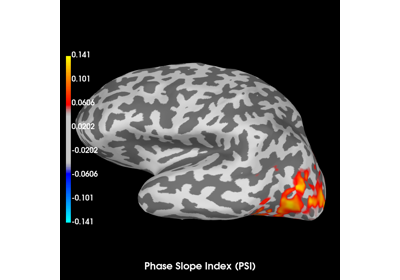mne_connectivity.phase_slope_index¶
- mne_connectivity.phase_slope_index(data, indices=None, sfreq=6.283185307179586, mode='multitaper', fmin=None, fmax=inf, tmin=None, tmax=None, mt_bandwidth=None, mt_adaptive=False, mt_low_bias=True, cwt_freqs=None, cwt_n_cycles=7, block_size=1000, n_jobs=1, verbose=None)[source]¶
Compute the Phase Slope Index (PSI) connectivity measure.
The PSI is an effective connectivity measure, i.e., a measure which can give an indication of the direction of the information flow (causality). For two time series, and one computes the PSI between the first and the second time series as follows
indices = (np.array([0]), np.array([1])) psi = phase_slope_index(data, indices=indices, …)
A positive value means that time series 0 is ahead of time series 1 and a negative value means the opposite.
The PSI is computed from the coherency (see spectral_connectivity), details can be found in [1].
- Parameters
data : array-like, shape=(n_epochs, n_signals, n_times)
Can also be a list/generator of array, shape =(n_signals, n_times); list/generator of SourceEstimate; or Epochs. The data from which to compute connectivity. Note that it is also possible to combine multiple signals by providing a list of tuples, e.g., data = [(arr_0, stc_0), (arr_1, stc_1), (arr_2, stc_2)], corresponds to 3 epochs, and arr_* could be an array with the same number of time points as stc_*.
indices : tuple of array | None
Two arrays with indices of connections for which to compute connectivity. If None, all connections are computed.
sfreq : float
The sampling frequency.
mode : str
Spectrum estimation mode can be either: ‘multitaper’, ‘fourier’, or ‘cwt_morlet’.
fmin : float | tuple of float
The lower frequency of interest. Multiple bands are defined using a tuple, e.g., (8., 20.) for two bands with 8Hz and 20Hz lower freq. If None the frequency corresponding to an epoch length of 5 cycles is used.
fmax : float | tuple of float
The upper frequency of interest. Multiple bands are dedined using a tuple, e.g. (13., 30.) for two band with 13Hz and 30Hz upper freq.
tmin : float | None
Time to start connectivity estimation.
tmax : float | None
Time to end connectivity estimation.
mt_bandwidth : float | None
The bandwidth of the multitaper windowing function in Hz. Only used in ‘multitaper’ mode.
mt_adaptive : bool
Use adaptive weights to combine the tapered spectra into PSD. Only used in ‘multitaper’ mode.
mt_low_bias : bool
Only use tapers with more than 90% spectral concentration within bandwidth. Only used in ‘multitaper’ mode.
cwt_freqs : array
Array of frequencies of interest. Only used in ‘cwt_morlet’ mode.
cwt_n_cycles : float | array of float
Number of cycles. Fixed number or one per frequency. Only used in ‘cwt_morlet’ mode.
block_size : int
How many connections to compute at once (higher numbers are faster but require more memory).
n_jobs : int
How many epochs to process in parallel.
verbose : bool | str | int | None
If not None, override default verbose level (see
mne.verbose()and Logging documentation for more). If used, it should be passed as a keyword-argument only.- Returns
psi : array
Computed connectivity measure(s). The shape of each array is either (n_signals, n_signals, n_bands) mode: ‘multitaper’ or ‘fourier’ (n_signals, n_signals, n_bands, n_times) mode: ‘cwt_morlet’ when “indices” is None, or (n_con, n_bands) mode: ‘multitaper’ or ‘fourier’ (n_con, n_bands, n_times) mode: ‘cwt_morlet’ when “indices” is specified and “n_con = len(indices[0])”.
freqs : array
Frequency points at which the connectivity was computed.
times : array
Time points for which the connectivity was computed.
n_epochs : int
Number of epochs used for computation.
n_tapers : int
The number of DPSS tapers used. Only defined in ‘multitaper’ mode. Otherwise None is returned.
References
- [1] Nolte et al. “Robustly Estimating the Flow Direction of Information in
Complex Physical Systems”, Physical Review Letters, vol. 100, no. 23, pp. 1-4, Jun. 2008.
